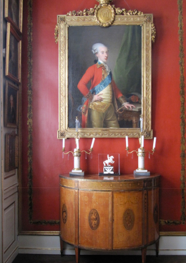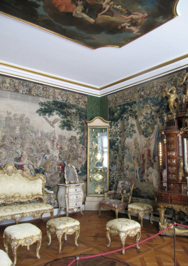castle Interior II
Rosenborg Castle
Copenhagen, denmark
jutland peninsula, northern europe
july 16, 2010


castle Interior II
Rosenborg Castle
Copenhagen, denmark
jutland peninsula, northern europe
july 16, 2010


King Christian IV lived most of his life at Rosenborg Castle. His coronation was at the age of 18 in 1594, and he reigned over Denmark-Norway for 59 years, the longest reigning monarch in the history of Denmark. He was curious and actively involved in architecture and ship design, and is remembered as one of the most remarkable of Danish kings. In his personal life, he married twice, the first marriage was in 1597 to Anne Catherine of Brandenburg daughter of the Duke of Prussia. She died 14 years later. During their marriage she gave birth to seven children. Four years after her death, the king privately married Kirsten Munk, an attractive woman with whom he had a dozen children. It is believed that the king had at least 26 children, both legitimate and illegitimate. On the upper floors of Rosenborg Castle, the King had his private chambers on the northern end of the castle, while the Queen had hers on the southern end. The central part of the Castle was reserved as the King’s Audience room as well as the antechamber. Christian IV died in Rosenborg Castle on February 28, 1648. He is buried in Roskilde Cathedral together with Queen Anne Catherine of Brandenburg. His his son and heir, Frederik III succeeded the throne and lived in Rosenborg until his death in 1670. Some changes were later made to the interior of the castle. For example, King Christian V (reigned 1670-1699) replaced Charles IV’s tapestries in the Long Hall in 1698, hanging the “Rosenborg Tapestries” that documented his victories over Sweden in the Scania Wars. These were commissioned by the King and woven by Flemish weavers in Copenhagen between 1684-93. King Christian VI’s rooms at Rosenborg Castle have tapestries illustrating the life of Alexander the Great, thought to have been the “test” for the commissioned Flemish weavers of the “Rosenborg Tapestries”. These hang in the former bedroom of Pincess Sophie Hedevig, sister to King Frederik IV. Most of the rooms at Rosenborg still have their original furnishings in place. The Great Hall was the room used for Royal banquets. In 1705-07, Frederik IV replaced the Long Hall ceiling paintings with an arched stucco ceiling in the baroque style.
PHOTOS: Left Column: 1. Early 18th century furnishings and paintings, with French influence. 2. One of the Christian VI’s rooms, of European (French and Italian) influence in furnishings including the tapestry, upholstery, gilt settee, and chandelier. 3. King Christian VI’s rooms at Rosenborg Castle with tapestries illustrating the life of Alexander the Great. Center, Top: Detail: hallway connecting the north and south ends of the castle. Leaded glass windows in the upper half of the hallway creates light and charm in this Dutch Renaissance building. Center, Middle: Birds in a gilded cage, also a clock. Center, Bottom: Painted and gilt chest with marble top in Christian VI’s rooms at Rosenborg Castle. Right Column: 1. Early 18th century painting, one of several portraits of the Danish royalty, influenced by French artists of the time. 2. 17th century chest with inlaid stone decorations. The painting above the chest is unique. The canvas is folded so that two portraits exist instead of one. In one direction, a portrait of Christian IV is seen; from another direction, a portrait of his wife, Anne Catherine of Brandenburg is visible. 3. The “most modern of rooms” in the Castle, of uniquely Danish styled furnishings.


Royal Grandeur







